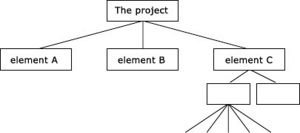Where do projects come from?
The idea
Essentially, any project begins with an idea. The idea is often one about how to do something that seems to be needed. Transforming ideas into projects begins with recognising the nature of this driving force:
Projects arise in order to meet human needs. A need emerges and is recognized, and the management determines whether a need is worth fulfilling. If it is, a project is organized to satisfy the need. Thus, needs are the fundamental driving force behind projects. This seminal aspect of needs makes them important for project management. Their emergence sets off the whole project process. If at the outset we do not understand a need and its implications, if we incorrectly articulate it, or if we mistakenly address the wrong need, we have gotten off to a bad start and can be certain that our project will be trouble-filled. (Frame, 1987)
Frame identifies three phases in the identification of needs:
- Needs emergence – all sectors face the continual emergence of new needs in a changing organisational environment. Needs can evolve both from within and from outside an organisation. All stakeholders have interests in anticipating and predicting needs and responding to them proactively.
- Needs recognition – recognising a need requires organisations to make use of existing data and expertise both from inside and out, and to collect additional data in order to consult stakeholders and to identify the implications of changing conditions. In project management terms, this phase is concerned with shaping an emergent need into the goals that will begin to define the outputs or outcomes of the project.
- Needs articulation – this phase involves clarifying the understanding of a need by describing its characteristics more precisely. This enables managers to identify the most appropriate way of meeting the need, it enables stakeholders to contribute to the developmental process, and it leads to a precise statement of what must be done or provided to meet the need – the project definition.
Sometimes the strategic need for a project is determined by senior managers and the project goals are determined before project managers and staff are involved. For example, if an organisation decides at board level that a new headquarters building is to be commissioned and sited in a new location, staff may not be consulted until the decision has been made. However, it is not unusual for project goals to be identified by those working within a changing setting, particularly if these people might be considered to be very familiar with the needs that are to be addressed by the project.
In clarifying a project's scope, information needs to be collected about:
- who the stakeholders are and what their interests are in the project;
- the project's aims and objectives and how the project is going to achieve them within appropriate resource and time constraints;
- the opportunities offered by the project and the threats to its success.
There are also tools that can help to get a better understanding of the project. These include mind mapping and a task breakdown chart.
Mind mapping
The term ‘Mind mapping’ was devised by Tony Buzan for the representation of ideas, notes, information, etc., in radial tree-diagrams – sometimes also called ‘spider diagrams’. These are now very widely used. Try a web search on ‘Buzan’, ‘mind map’ or ‘concept map’. Alternatively select the Compendium option of this OpenLearn unit. Compendium is open source software that allows you to create a variety of mind, concept or knowledge maps and can be downloaded in LabSpace. If you would like full details about using it, click here.
To draw a mind-map (manually)
- Put your paper (ideally a large sheet) in landscape format and write a brief title for the overall topic in the middle of the page.
- For each major sub-topic or cluster of material, start a new major branch from the central topic, and label it.
- Each sub-sub-topic or sub-cluster forms a subsidiary branch to the appropriate main branch.
- Continue in this way for ever finer sub-branches.
- You may find that you want to put an item in more than one place. You could just copy it into each place. Alternatively, you could draw in a cross-link.
- You may find that you want to show relationships between items on different branches. You can do this by coding them using colour, type of writing, etc.
- You may find that it helps to bring the map to life if you identify particular branches, items, etc., with drawings, etc.
(Source: Buzan, T. (1982) Use Your Head, London, Ariel Books)
There are several mind mapping software packages, such as Compendium, available. They make it very much easier to edit and rearrange the map, they can sometimes hold notes and documents, etc. associated with labels (so that they can act as filing systems), and some can convert between map and text outliner formats. Figure 4 shows an example of a Compendium created mind map. The original file can be accessed by clicking this link.
You may be thinking that if the factors for success are well known, why do projects still fail? Managers often have to manage projects alongside their other tasks. The time and effort needed to plan the project may seem too great when other tasks are pressing. There is little to show in the planning stages and managers are often tempted to start on something where the action can be more visible.
Task breakdown chart
The task breakdown technique is a very logical approach to identifying the tasks involved in a project. Some people may find it suits them better than using mind maps; other people may find the techniques complement each other.
To do a task breakdown chart, first draw a box at the top of a page with the project title inside it. Then mentally identify the main elements that go to make up the project as shown below.
A further degree of task breakdown has been indicated on item C, and could have been shown for elements A and B as well. In general terms it is for the individual to decide the level of detail to which they wish to go.

